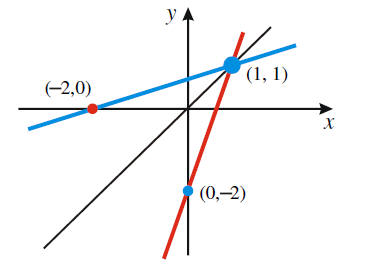Inverse Functions
Finding The Inverse of a Function
In the beginning of this section when we defined functions by giving a table
of data we found the inverse by
interchanging the two columns of data.
If a function is described by an expression, to find the rule that defines a
function’s inverse we interchange the
x’s and the y’s in the expression, and then solve for y. For the inverse to be a
function we must guarantee that
the original function is one-to-one.
Example 1: Find f-1 for
 Verify your results using the property of
inverse functions.
Verify your results using the property of
inverse functions.
Support your conclusion graphically.
Solution:
We know that the graph of the line
 passes the horizontal line test , and is therefore a
passes the horizontal line test , and is therefore a
one-to-one function. To prove that f is one-to-one algebraically, we use the
definition of one-to-one to
show that
 Therefore, f is one-to-one.
Therefore, f is one-to-one.
Write the function as

Interchange the x and the y:

Solve for y:

 [The
resulting y is f-1.]
[The
resulting y is f-1.]
•Verify your results by showing that


•Support graphically by showing that the graphs of f and f-1 have
symmetry about the line y= x.
x.
Example 2: The function
 is not a one-to-one function. Restrict the domain of f so that its
is not a one-to-one function. Restrict the domain of f so that its
inverse will be a function.
Solution: Note from the graph of f, the part of the graph on either side of
the line x=0 is one-to-one.
Therefore, we will restrict the domain to be


Domain of f is

Range of f is

Example 3: In the above example we restricted the domain of
 so that f has an inverse
so that f has an inverse
function. Find f-1 and its domain and range.
Solution: The domain of f was restricted to x≥0, and the range is y≥-4 so that f is one-to-one.
•We write:

•Interchange x and y:
 [Interchange
domain and range.]
[Interchange
domain and range.]
•Solve for y:

Since y≥0, we use only the positive root.

•Domain of f-1:

Range of f-1:


